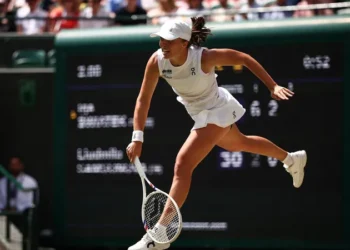Carlos Alcaraz, the reigning Wimbledon champion, has ignited debate in the tennis world by calling for a “drastic” overhaul of the time-violation rule after being handed a warning at the Queen’s Club Championships ahead of Wimbledon. The 22‑year‑old Spaniard, fresh from marathon battles and multiple titles on grass, took issue with the rigid enforcement of the 25‑second rule that governs time between points, arguing it harms both players and the spectacle.
⚠️ What happened at Queen’s Club?
During his epic third-round match against Jaume Munar—one of the longest in tournament history, lasting about three and a half hours—Alcaraz received an official time warning from the chair umpire. Under ATP regulations, players are allowed 25 seconds between points, with no prior notice when the time is about to expire; exceeding the limit can result in penalties .
After a long, physically draining rally, Alcaraz reached for a towel, wiped his hands, and found himself penalized for exceeding the time limit. Coming immediately off deep exchanges and battling fatigue and heat, he felt the rigid enforcement drained not only his preparation but also the flow of play.
🎙️ Alcaraz’s outburst
In his post‑match press conference, Alcaraz wasted no mince words: he admitted the extended rally and scorching heat demanded more recovery time. “We’ve been playing for three hours… we just finished a long point at the net, they should allow for a bit of leeway and give us more time,” he asserted . He emphasized that the rule “hurts the show,” stating “it’s not great for the fans or for us either” .
He also suggested inconsistencies in how umpires apply the rule, even hinting at possible bias: “Maybe she [the umpire] wanted to be the centre of attention today” . Alcaraz hopes officials will inject more flexibility and discretion into timing regulations—especially during multi-hour contests, in extreme conditions, or after extended rallies.
Why this caught fire
Alcaraz, already a global tennis darling with five Grand Slams and two Wimbledon crowns, brings star power to the issue. At Queen’s, he claimed his 15th straight victory after conquering both Rome and Roland‑Garros . His polished performances on grass and relentless intensity lend weight to his critique: this isn’t a fluke; it’s a consistent barrier to optimal play and real entertainment.
The incident underscores a broader tension in modern tennis: balancing strict time enforcement for pacing and TV schedules versus preserving the sport’s natural flow, player strategy, and fairness. Since its introduction, the shot clock and 25-second rule have modernized the game. Yet, they don’t always account for real‑world variances—exhausting rallies, hot weather, or complex point conclusions—leaving athletes feeling prematurely rushed.
The rule in detail
According to the ATP rulebook: *“A Time or Code Violation must be assessed if the ball is not struck for the next point within the twenty‑five (25) seconds allowed, except if the Chair Umpire extends the time for special circumstances. There is no time warning prior to expiration of the twenty‑five seconds.”*
While umpires can delay the shot clock start in noisy arenas or after unusually long rallies, this remains discretionary. Alcaraz argues this discretionary power is underused, especially at Grass‑court events that often produce physically taxing affairs.
What change is Alcaraz proposing?
Though Aldcaraz has not submitted a formal proposal, he emphasized two key priorities:
1. Discretion based on context – Umpires should actively pause the shot clock following long rallies, in extreme weather, or during high-stakes moments.
2. Transparent timing policies – Players (and fans) should know in advance when and why timing extensions occur—or don’t—to avoid distractions and accusations of inconsistency.
He believes this would reduce arbitrary penalties, preserve rhythm, and elevate both performance and spectator experience.
How has tennis reacted?
The commentary has been mixed:
Officials argue the shot clock enforces discipline, deters deliberate delays, and ensures broadcast‑friendly pacing.
Some players, especially on the ATP tour, sympathize, acknowledging the rule sometimes feels overly rigid.
Fans and media have weighed the trade‑offs: while pacing is crucial, over‑enforcement risks diminishing the drama and flow inherent in tournament tennis.
Alcaraz’s heightened profile increases the stakes—his call may compel serious re-evaluation by tennis authorities, especially if other top players lend support.
Looking ahead to Wimbledon
With Queen’s now behind him, Alcaraz heads into Wimbledon on the heels of his warning incident—and amidst intense scrutiny of the time rule. Wimbledon begins June 30, and as a two‑time reigning champion (2023, 2024), Alcaraz is a front‑runner . His critics will look to see whether the rule stays or is softened for grass‑court conditions.
If his complaint resonates, umpires might grant wider on‑court discretion, especially during long matches in adverse conditions. That would mark a major departure from today’s “one-size-fits-all” 25-second rule—and could alter how key moments in Grand Slams are officiated.
Final serve
Carlos Alcaraz’s demand isn’t a minor quibble—it reflects a clash between modern tennis rules and the raw physicality of extended matches. His high-profile call for flexibility underscores the need for officiating that adapts to real-time conditions, rather than enforcing penalties rigidly. With Wimbledon looming, his challenge may catalyze serious discussions—and
potentially meaningful rule change—across the sport.











